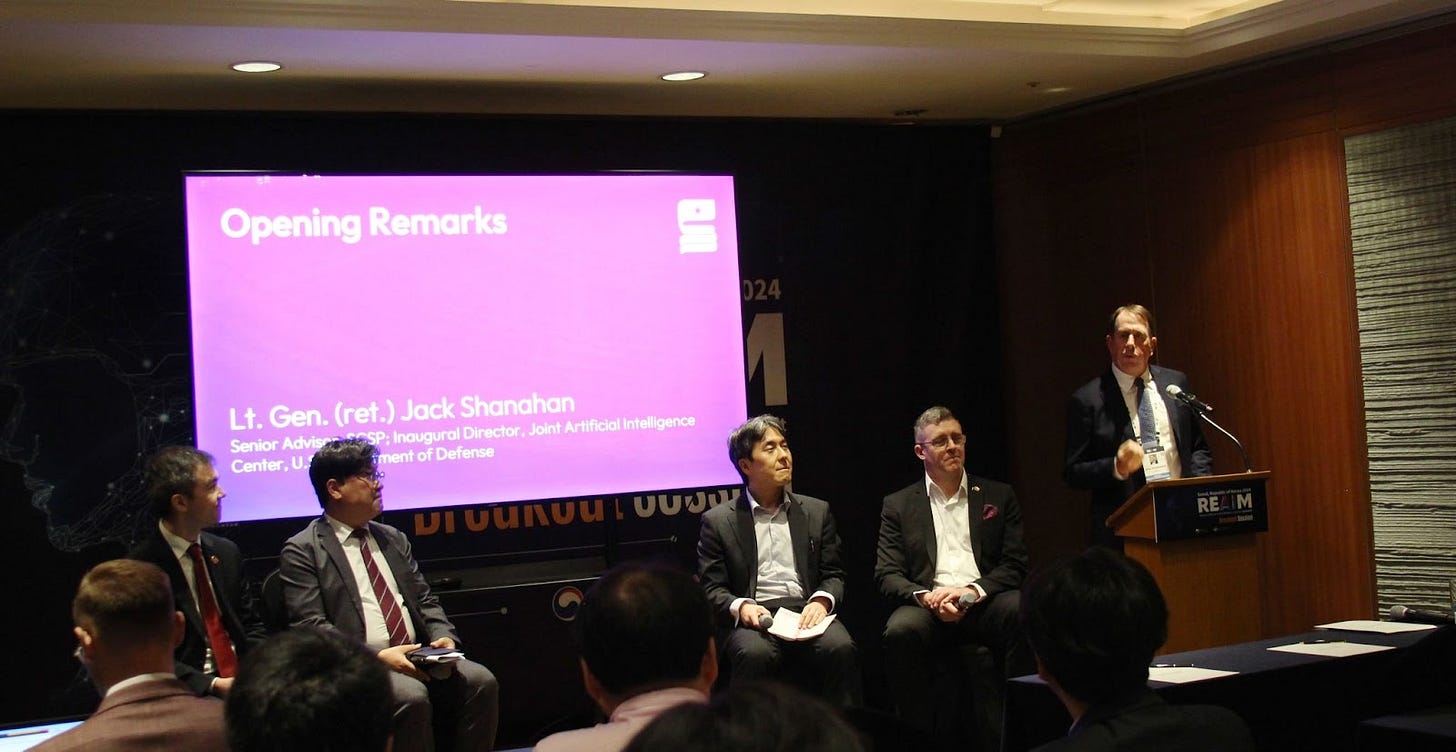Combined Innovation: Achieving Next Level Interoperability with Indo-Pacific Allies
Hello, I’m Ylli Bajraktari, CEO of the Special Competitive Studies Project. In today’s edition of our newsletter, Paul Lyons and Luke Vannurden discuss their recent trip to Seoul, South Korea for the 2nd Responsible AI in the Military Domain (REAIM) Summit, where they hosted a panel discussing the implementation of AI across the U.S. defense enterprise and with its allies and partners in the Indo-Pacific region.
Combined Innovation: Achieving Next Level Interoperability with Indo-Pacific Allies
America has a historically unique strength – its alliances. Our combined military power underpins our peace and security, advances our national interests, promotes our prosperity, and upholds the wider international order. It does so on the back of interoperability – the operational and technological tissue that connects the militaries of the United States and its allies and partners. Interoperability provides allied forces the “ability to act together coherently, effectively, and efficiently to achieve combined tactical, operational, and strategic objectives.”
So what happens to interoperability with the introduction of AI? What happens if or when each nation acquires its own hardware, develops its own algorithms, and builds its own security protocols? And, importantly, what happens when each nation ends up with different outputs from its AI-powered battlespace awareness aids, battle space management tools, and command and control systems?
The United States and its allies should start asking these questions now, when the adoption of AI is still in its early stages, so that they can establish shared plans and intentions, and explore how they can move collectively and deliberately – before we operate dynamically as a combined coalition force.
Enter REAIM Summit 2024
To answer some of these questions, SCSP convened a panel on Building an AI Capability Framework for Improved Coordination at the 2nd Responsible AI in the Military Domain (REAIM) Summit, which took place in Seoul on September 9-10. This year’s summit continued the dialogue on governance frameworks and use cases, as well as the intersection of the two from an ethical, legal, societal, and risk perspective. The SCSP panel brought together leading experts from the defense departments of Australia, Japan, South Korea, and the United States to explore sovereign AI strategies, data sharing and security, the needs of digital infrastructure, assurance of AI capabilities, and the means of cross-military stress testing of AI.
Judging by the panel’s standing room-only attendance, technologists, strategists, defense experts, and ethicists were keenly interested to learn about the current status of AI implementation across sovereign military approaches – and how to ensure existing interoperability is not compromised.
SCSP thanks Dr. Paul Robard of Australia, Dr. Kiho Kwak of South Korea, Mr. Shimpei Ara of Japan, Dr. Matthew Kuan Johnson of U.S. DoD’s CDAO, and SCSP Defense Panel Senior Advisor, LtGen (ret.) Jack Shanahan, for supporting SCSP’s panel at the REAIM Summit 2024. In addition, SCSP commends ROK Ministry of Foreign Affairs (MOFA) and Ministry of National Defense (MND) for their expert coordination and execution of the REAIM Summit 2024.
Here are some of the themes that we heard during the panel discussion:
Moving forward – not back. Current high levels of interoperability must not be jeopardized by AI adoption. Therefore, moving deliberately, and in-step, will be vital to adopting AI’s full potential.
Robust communication is a must. As allies move out with their sovereign plans for AI adoption, transparent communication will be necessary to synchronize efforts and proactively identify interoperability challenges early.
Let’s start mission stress testing. To move to action, missions such as Integrated Air and MIssile Defense (IAMD) may be an area to begin combined, limited experimentation – to include exercising under controlled conditions. Building on existing interoperability in this important mission area, AI experimentation within IAMD would permit greater fusion of data inputs from combined intelligence, sensors, shooters, and weapons to cooperatively address regional threats.
Best if we share lessons learned. As allies navigate their adoption and implementation plans, pooling and sharing early observations will be vital.
The key is trusted data, standards, and strong security. The data foundations that power AI must be standardized, trusted and securely protected. Fine detail issues such as data sharing protocols and aggregation across allies – against the rigors of operating environments – require extensive collaboration to enhance the combined power of AI.
The consensus is that “we’ve been down this road before.” But the complexity of leveraging AI to its full extent increases the due diligence required.
Let’s not forget NATO
While SCSP’s focus at REAIM was to broaden the dialogue with America’s Indo-Pacific allies, we also furthered our long standing collaboration with NATO by participating in the organization’s, Integrating AI Responsibly: Progress and Future Directions for NATO panel. With representatives from Japan and Dutch governments and universities, SCSP highlighted new structural approaches released by the DoD’s Chief Digital and Artificial Intelligence Office (CDAO). These approaches exemplify and institutionalize the DoD’s commitment to responsible AI adoption – a Responsible AI Toolkit (released with a NATO version), a Defense AI Guide on Risk (DAGR) Risk Assessment, and a Shield Planning Process. We also discussed aspects of our Vision for Competitiveness, explaining that an innovation race requires a blueprint for success, and that this need goes well beyond the military domain, to include intelligence, the economy, society, foreign policy, and technological superiority. Of course, the United States has done this before, particularly during the Cold War.
Let’s put this in a Broader Context
But what about strategic stability? Our adversaries, particularly China, are committed to achieving first mover advantage with AI - and are moving forward with conviction. This is a critical point that needs to be kept in mind, particularly in response to those who are focused on a guardrails-first adoption strategy. Speaking on the panel on Responsible Military Use of AI: Bridging the Gap Between Principles and Practice, co-hosted by Carnegie Council for Ethics in International Affairs and the Oxford Institute for Ethics, Law and Armed Conflict (ELAC), we highlighted that technology will have agency across diplomacy, deterrence, and defcanvaeating an adversary.
As such, the Blueprint for Action that was released at the REAIM, building upon the “Call to Action” from the 1st REAIM Summit last year, should galvanize the international community to cohere around a shared vision and understanding of principles and normative values surrounding responsible AI adoption. But, if that is to happen, we need everyone on the same page. Non-signatories of the Blueprint and the Political Declaration on Responsible Military Use of Artificial Intelligence and Autonomy have undermined strategic deterrence by introducing uncertainty into the equation.
The REAIM Summit 2024 affirmed the need for the United States to formulate a vision and accompanying blueprint to prevail in the innovation race and battle the geostrategic headwinds that we are facing. It’s time for the United States to go to work with its allies!







